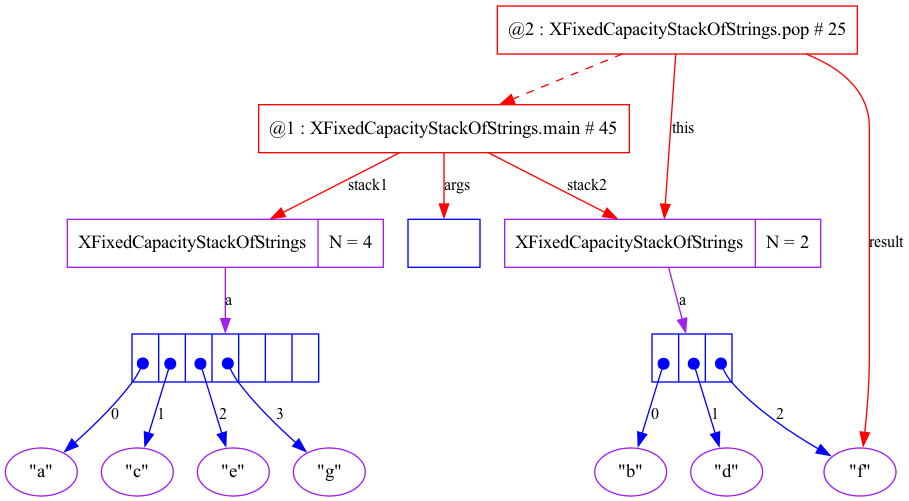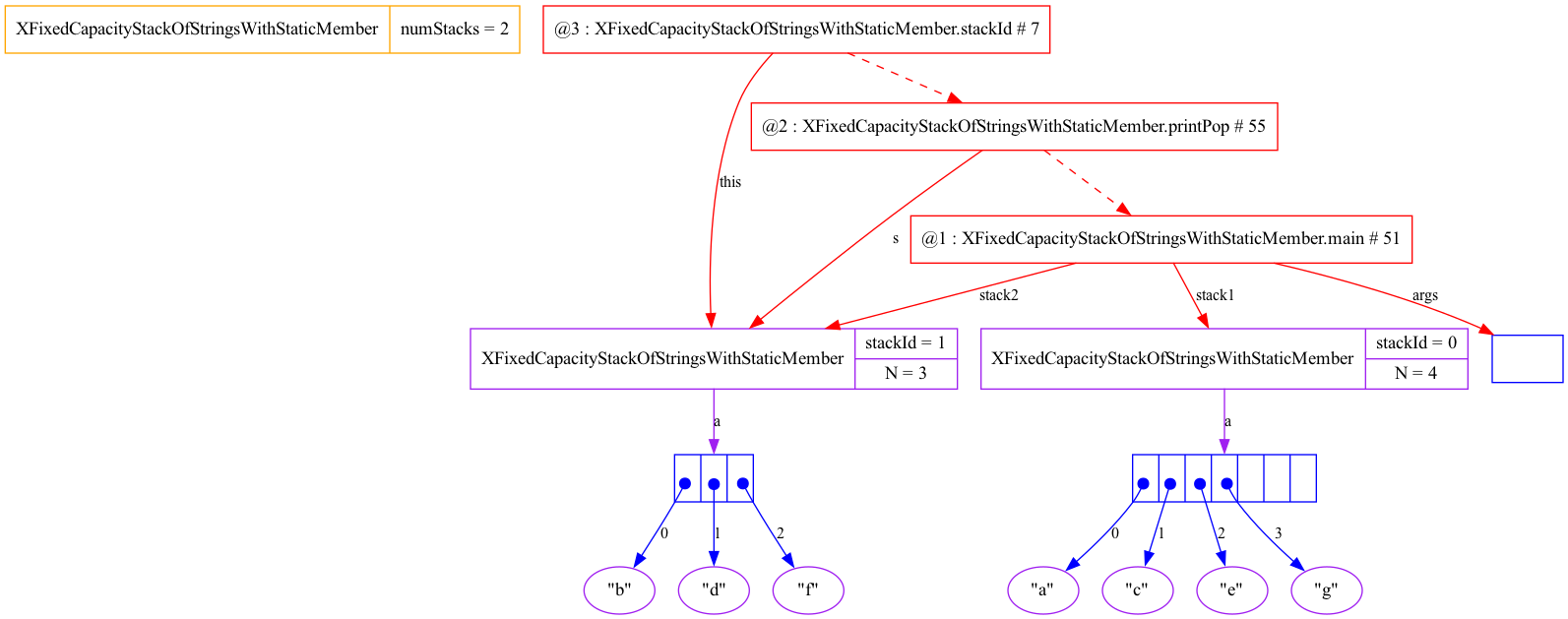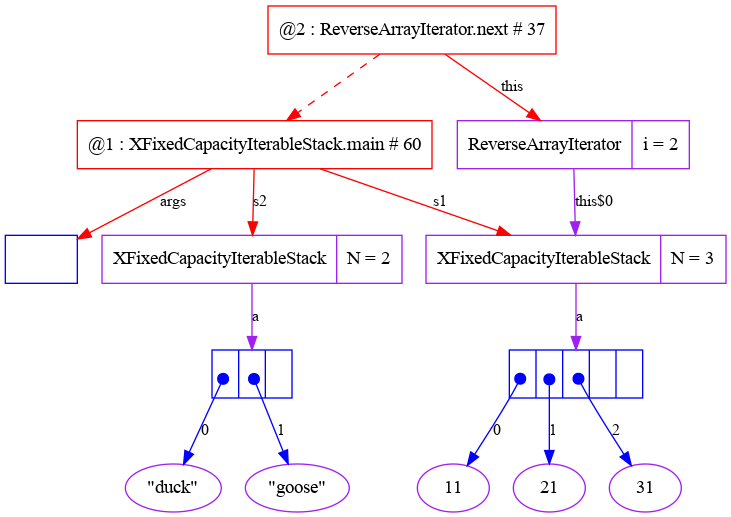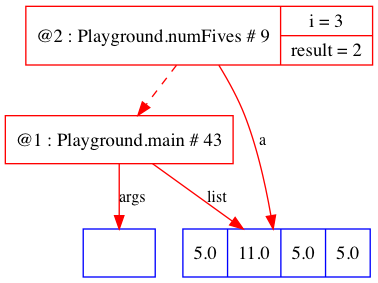| Contents [0/9] |
| Abstract Data Type (ADT) [1/9] |
| ADTs in Java [2/9] |
| Data structure [3/9] |
| Fields and methods [4/9] |
| Static fields and methods [5/9] |
| Generic classes [6/9] |
| Interfaces [7/9] |
| What is memory? [8/9] |
| Summary: Data structures in Java [9/9] |
(Click here for one slide per page)
| Abstract Data Type (ADT) [1/9] |
An Abstract Data Type (ADT) specifies
For example, a stack (think of a stack of plates) includes the operations to :
s
| ADTs in Java [2/9] |
In Java we write this as follows (using Strings instead of plates):
01 |
package algs13; public class StackOfStrings { public StackOfStrings { /* ... */ } public boolean isEmpty () { /* ... */ } public void push (String item) { /* ... */ } public String pop () { /* ... */ } } |
We use the ADT as follows:
08 |
StackOfStrings stack = new StackOfStrings(); stack.push("a"); if (! stack.isEmpty()) { String item = stack.pop(); } |
Note that I've told you what the operations are, and how they should behave.
I've told you nothing about how the operations are implemented.
When we look at a specific implementation, this is what we call a data structure.
| Data structure [3/9] |
A data structure provides code to implement an ADT.
The most important choice is how to store data.
For stack, we will look at two choices:
The way we choose to store the data affects the performance of the operations!
| Fields and methods [4/9] |
Local variables are stored in method invocations. Fields are stored in objects.
Fields are sometimes called member variables or instance variables.
file:XFixedCapacityStackOfStrings.java [source]
01
02
03
04
05
06
07
08
09
10
11
12
13
14
15
16
17
18
19
20
21
22
23
24
25
26
27
28
29
30
31
32
33
34
35
36
37
38
39
40
41
42
43
44
45
46
47
48
49
50
51
52

| Static fields and methods [5/9] |
The keyword static changes the meaning of fields and methods.
file:XFixedCapacityStackOfStringsWithStaticMember.java [source]
01
02
03
04
05
06
07
08
09
10
11
12
13
14
15
16
17
18
19
20
21
22
23
24
25
26
27
28
29
30
31
32
33
34
35
36
37
38
39
40
41
42
43
44
45
46
47
48
49
50
51
52
53
54
55
56
57
58
59
60
61
62
| Storage | Where stored? | When allocated? |
|---|---|---|
| static | stored with class | when class loaded |
| nonstatic | stored with object | when object allocated (with new) |
| local variable | stored with method invocation | when method called |
| Method | Has "this"? |
|---|---|
| static | no |
| nonstatic | yes |

| Generic classes [6/9] |
A generic class has a type parameter. Type is not stored at runtime.
file:XFixedCapacityStack.java [source]
01
02
03
04
05
06
07
08
09
10
11
12
13
14
15
16
17
18
19
20
21
22
23
24
25
26
27
28
29
30
31
32
33
34
35
36
37
38
39
40
41
42
43
44
45

| Interfaces [7/9] |
Some language features use special interfaces, such as Iterable.
An Iterator is a design pattern.
Iterator allows you go through the elements of a data structure without imposing on the data sturcture itself.
Iterable is an interface that gives you access to an Iterator.
file:XFixedCapacityIterableStack.java [source]
01
02
03
04
05
06
07
08
09
10
11
12
13
14
15
16
17
18
19
20
21
22
23
24
25
26
27
28
29
30
31
32
33
34
35
36
37
38
39
40
41
42
43
44
45
46
47
48
49
50
51
52
53
54
55
56
57
58
59
60
61
62
63
64
65
| Nonstatic | Static | |
|---|---|---|
| field | stored with object | stored with class |
| method | has "this" | does not have "this" |
| class | has "this$0" | does not have "this$0" |

| What is memory? [8/9] |
What does the machine memory look like when you see a picture like this:

To fully answer this question, you need to take the systems classes. But it is useful to have an idea of the memory, even if the details are not exactly correct.
| Method calls (Stack) | Objects (Heap) | |||||||||||||||||||||||||||||||||||||||||||||||||||
|---|---|---|---|---|---|---|---|---|---|---|---|---|---|---|---|---|---|---|---|---|---|---|---|---|---|---|---|---|---|---|---|---|---|---|---|---|---|---|---|---|---|---|---|---|---|---|---|---|---|---|---|---|
|
|
Above, I show two parts of memory. On the left is storage for
method calls (commonly called the stack), on the right is
storage for objects (commonly called the heap). Arrays are
objects in java. Machine addresses are shown as hexadecimal numbers
beginning with the prefix 0x.
Each entry includes some overhead.
getClass() method. If you are interested, you can
read
more.
| Summary: Data structures in Java [9/9] |
Abstract data types are implemented as data structures.
Data structures are realized in Java using classes.
We hold the data associated with a data structure using fields (aka member variables or instance variables).
Fields are different from local variables, which are stored in methods.
Note: Static fields and methods, generic classes, and interfaces are not covered on exams.
Tracing code, as we covered in class last week, MAY be on the exam.
We are talking about these topics to help you read the code.
They will be revisited in SE350/SE450, CSC347/CSC447 and CSC373/CSC406/CSC407.